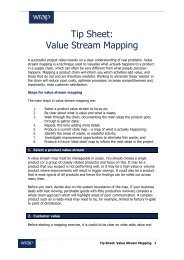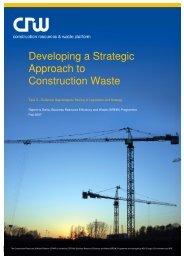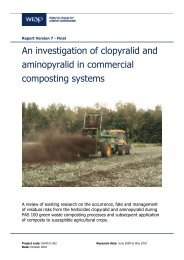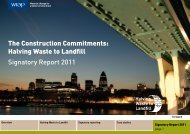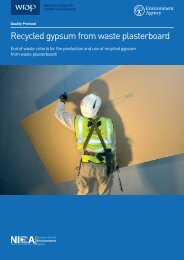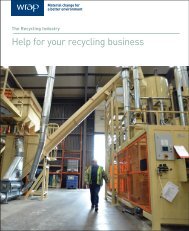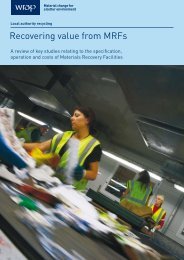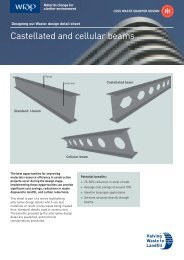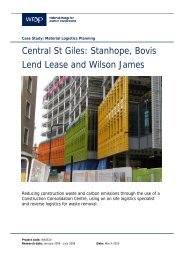Delivering effective Waste Minimisation - Wrap
Delivering effective Waste Minimisation - Wrap
Delivering effective Waste Minimisation - Wrap
Create successful ePaper yourself
Turn your PDF publications into a flip-book with our unique Google optimized e-Paper software.
18 <strong>Delivering</strong> <strong>effective</strong> <strong>Waste</strong> <strong>Minimisation</strong><br />
2.1.3 Communication throughout<br />
the design process<br />
Those opportunities to reduce waste identified<br />
in the communication section are of particular<br />
importance during the development of the<br />
design. In particular, designers should be<br />
encouraged to:<br />
engage with contractors and their<br />
subcontractors;<br />
commit to the development of a waste<br />
minimisation strategy (where the SWMP<br />
is not being developed);<br />
put waste on the agenda at design team<br />
meetings so that it can be discussed<br />
openly; and<br />
hold waste minimisation workshops<br />
to specifically target areas of waste.<br />
2.1.4 Change management<br />
Changes to design and construction can occur<br />
at any stage of a project and regularly result in<br />
increased waste due to completed work having<br />
to be modified. Avoiding change, or at least<br />
managing the change process <strong>effective</strong>ly, is<br />
an important aspect of waste minimisation.<br />
Figure 2.2: Comparison of a simple building (i.e. cube) with<br />
a complex building<br />
For example, a square<br />
box structure should<br />
have less waste than<br />
a complex structure.<br />
Almost all interfaces<br />
require materials to<br />
be cut, and every cut<br />
results in waste.<br />
Below are some recommendations which will<br />
help reduce the impact or likelihood of design<br />
changes.<br />
Design Freezes – Freezing designs at<br />
critical milestones can help to ensure that<br />
previous decisions are not revisited and<br />
good work is not undone unnecessarily.<br />
Designers do face difficulties in limiting<br />
design changes due to client or site<br />
pressures. However, the issue of waste<br />
and sustainability should add strength<br />
to the design freeze logic.<br />
Design for change – Successful waste<br />
minimisation can be achieved by using<br />
designs that accommodate flexibility of<br />
materials’ usage. Consider materials that<br />
can be used for more than one purpose<br />
and minimising the range of materials<br />
used to accommodate change in material<br />
usage. For example – to provide flexibility<br />
on site, consider limiting the range of<br />
materials used so that there is flexibility<br />
to use materials in different areas.<br />
2.1.5 Preventing the need for change<br />
Clearly defined objectives from the client on<br />
what the design is required to achieve can<br />
help prevent changes being required due to<br />
misunderstandings. A lack of awareness may<br />
result in changes to the design having to be<br />
made later on in the contract. If changes are<br />
absolutely necessary then the consequences<br />
of these changes upon other aspects of the<br />
work should be carefully considered. Early<br />
contractor involvement can help identify where<br />
conflict may arise, and if change is necessary,<br />
the best way of performing such alterations.<br />
Regular monitoring during construction to<br />
ensure that work undertaken is to the required<br />
standard can prevent changes being needed<br />
once the construction is finished.<br />
2.1.6 Design with existing resources<br />
Where the site has a stock of materials that<br />
can be used (aggregates, reclaimed materials,<br />
existing buildings, services or roads) the<br />
designer should employ forward thinking and<br />
consider how these may be accommodated<br />
into the new design. Often creative reuse of<br />
existing elements can positively contribute<br />
to the finished building, whether as an<br />
architectural statement or simply as<br />
engineering fill. For more information please<br />
see WRAP, The efficient use of materials in<br />
regeneration projects.<br />
2.1.7 Designing for site conditions<br />
Site conditions should be adequately<br />
considered during the design phase. Where<br />
it is known that the site will face particular<br />
constraints which may impact on waste, then<br />
the design should accommodate strategies<br />
to manage this.<br />
For example, if the site is extremely<br />
tight and the chance of materials damage<br />
subsequently increased then the potential<br />
for offsite manufacture could be considered.<br />
Also, if the site is known to suffer poor<br />
weather, designing the works so that<br />
materials will be protected makes sense.<br />
For more information, please see WRAP,<br />
Achieving good practice <strong>Waste</strong> <strong>Minimisation</strong><br />
and Management.





